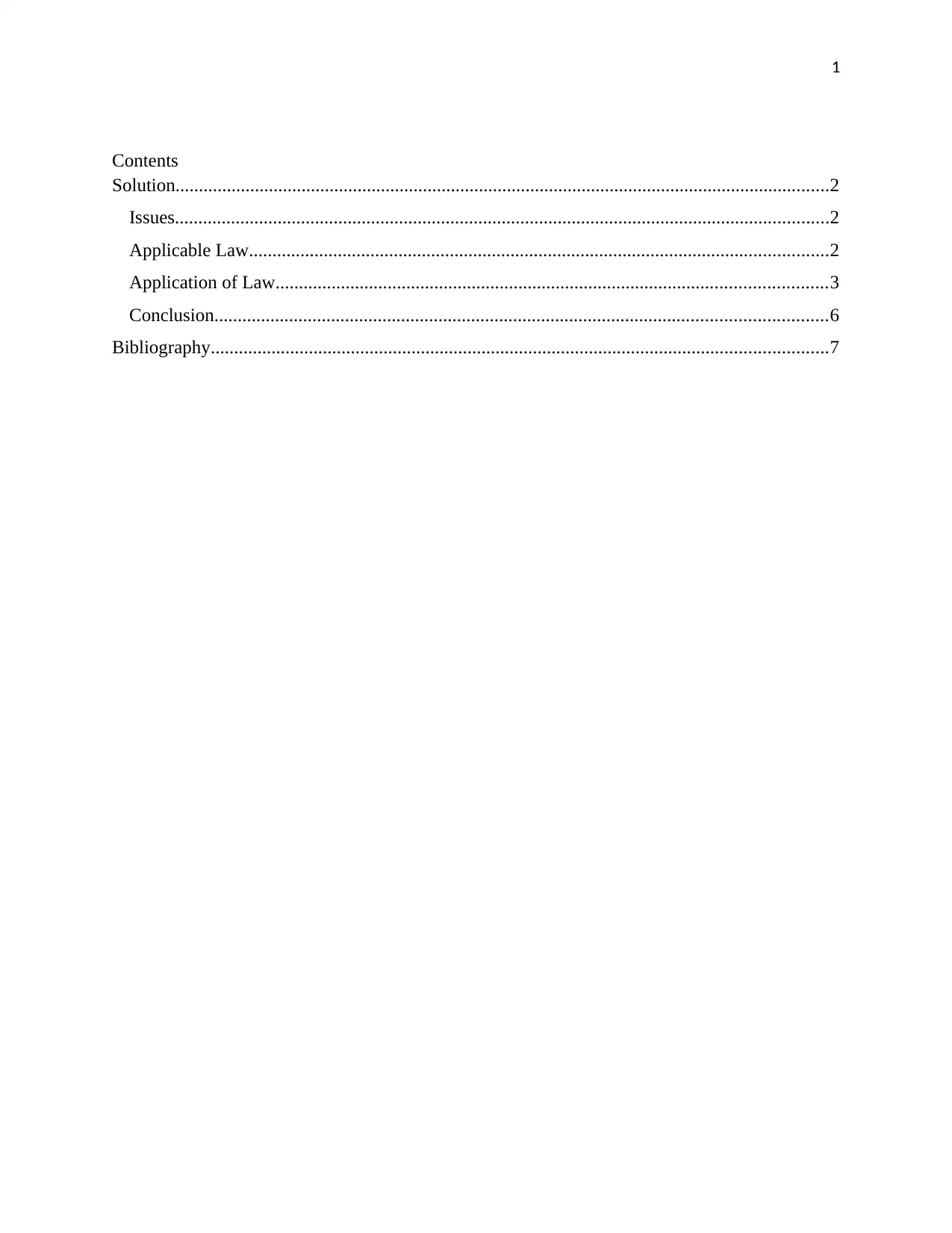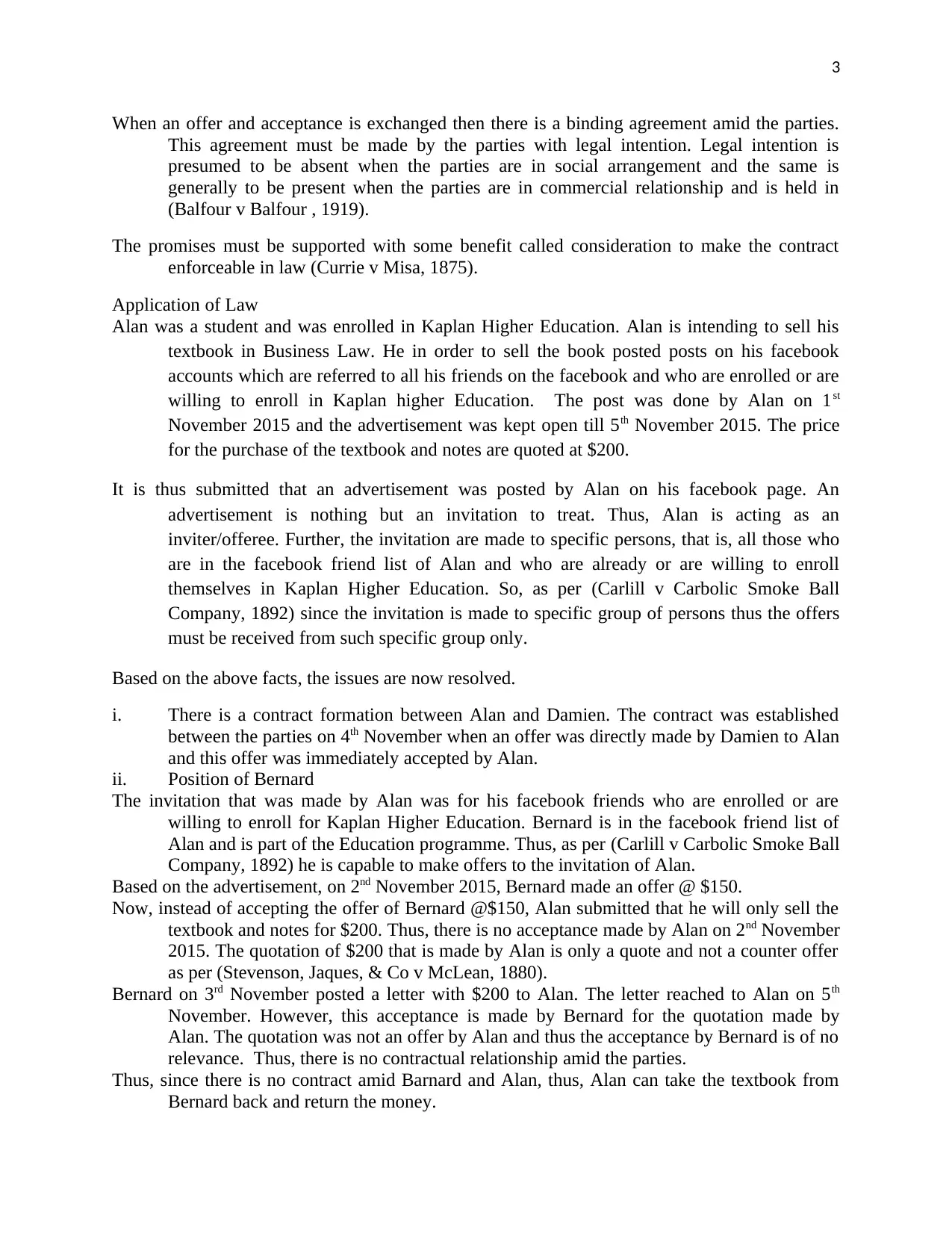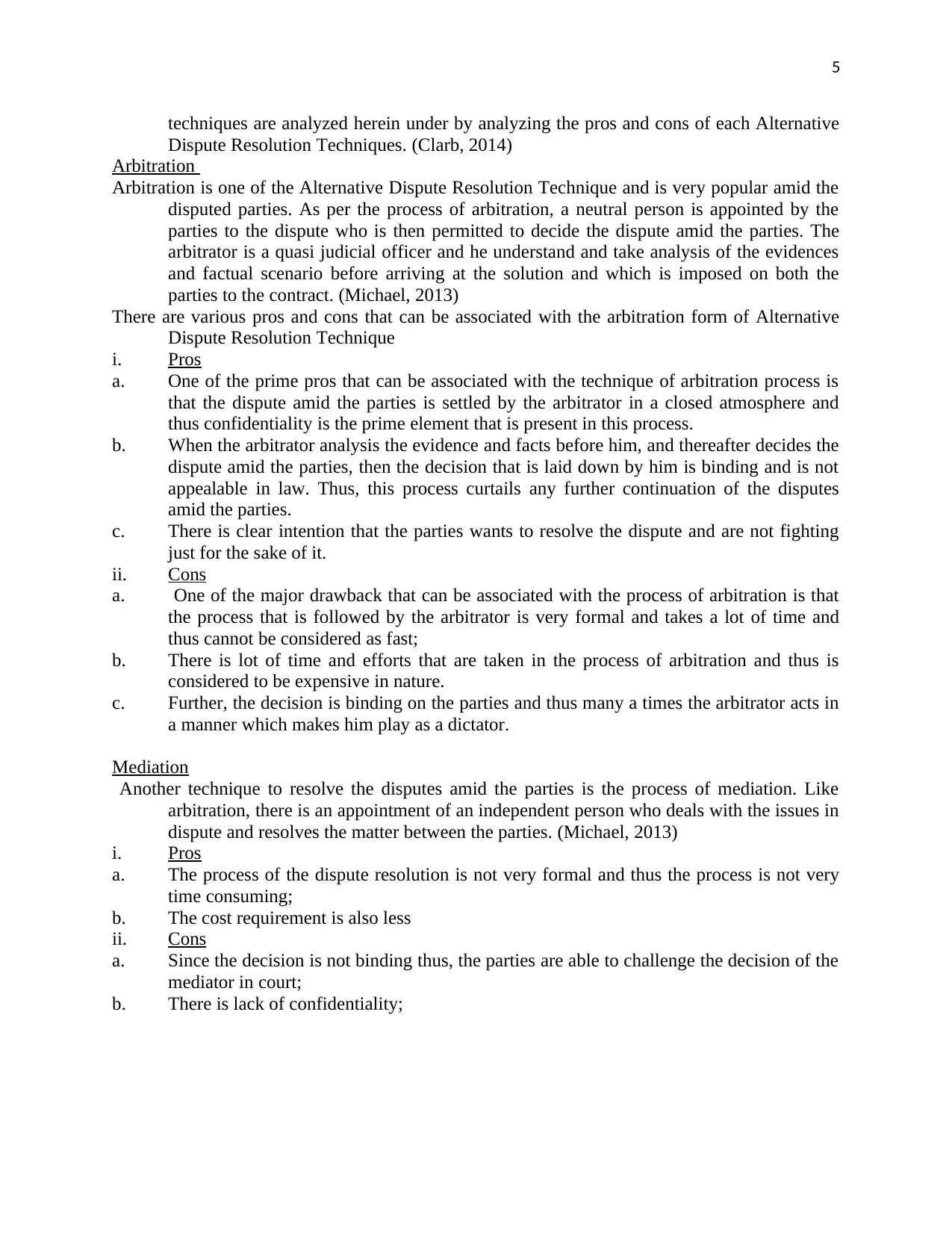Contract Formation and Analysis of Legal Positions
VerifiedAdded on 2023/04/21
|8
|2705
|455
AI Summary
This document discusses the formation of contracts, analyzes the legal positions of parties involved, and explores alternative dispute resolution options. It covers issues such as contract formation, legal positions of individuals, and alternative dispute resolution techniques like arbitration and mediation.
Contribute Materials
Your contribution can guide someone’s learning journey. Share your
documents today.

1
Contents
Solution............................................................................................................................................2
Issues............................................................................................................................................2
Applicable Law............................................................................................................................2
Application of Law......................................................................................................................3
Conclusion...................................................................................................................................6
Bibliography....................................................................................................................................7
Contents
Solution............................................................................................................................................2
Issues............................................................................................................................................2
Applicable Law............................................................................................................................2
Application of Law......................................................................................................................3
Conclusion...................................................................................................................................6
Bibliography....................................................................................................................................7
Secure Best Marks with AI Grader
Need help grading? Try our AI Grader for instant feedback on your assignments.

2
Solution
Issues
i. Is there any contact formation amid the parties, if yes, then, when it was formed and who
all are the contracting parties?
ii. Analysis of Bernard legal position and remedies?
iii. Analysis of Charleen legal position and remedies?
iv. Analysis of Damien legal position and remedies?
v. The various Alternative dispute resolution options available and pros & cons with these
options.
Applicable Law
The law of contract is a civil law which aims at establishing contractual association between the
parties. When any contractual association is formed then the parties to the contract are
required to comply with the terms of the contract. The essential elements of contract are
offer, acceptance, intention, capacity and consideration. (Jennifer, 2001)
The offer is the contract element which is initiated by an offeror. When any statement/proposal is
made by the offeror through which he tries to communicate his intention to carry any
act/omission by the offeree, then, such an act is an offer in contract law. (Gibson v
Manchester City Council, 1978) explains the concept of an offer. An offer can be made to
general public or to someone specific as per (Carlill v Carbolic Smoke Ball Company,
1892).
An acceptable is the second contract essential which follows an offer. The confirmation to the
offer by the offeree is called an acceptance in law and is held in (Empirnall Holdings Pty
Ltd v Machon Paull Partners Pty Ltd, 1988). Further, as per (Felthouse v Bindley, 1862),
an acceptance is necessary to come in the knowledge of the offeror to make it binding in
law. If there is no communication of acceptance then such an acceptance is invalid in
law. (Latimer, 2012)
But, when there is postal acceptance, then, the communication of the acceptance is complete
when the letter is posted by the offeree. As per (Adams v Lindsell, 1818) there is no need
for thee letter to reach the offeror to make the acceptance binding in law.
But, when no acceptance is made but changes are brought in the terms of the offer, then, such an
acceptance is counter offer which has the capacity to terminate the original offer and is
held in (Hyde v Wrench, 1840). The counter offer is the new offer which when confirmed
results in contract formation. Also, mere quotation or queries are not counter offer in law
and is held in (Stevenson, Jaques, & Co v McLean, 1880). (Gordon, 2016)
But, many a times, there are no offers which are given rather, a person wish to receive offers.
This act is called invitation to treat and an invitation can be attained with the help of
several means such as tenders, auctions, advertisements etc. in (Pharmaceutical Society v
Boots Chemists , (1953)) an invitation to treat is analyzed. When the people based on the
invitations make offer to the inviter then when such offers are approved by the inviter
then there is a valid contract establishment amid the parties and is rightly evaluated in
(Fisher v Bell , 1961).
Solution
Issues
i. Is there any contact formation amid the parties, if yes, then, when it was formed and who
all are the contracting parties?
ii. Analysis of Bernard legal position and remedies?
iii. Analysis of Charleen legal position and remedies?
iv. Analysis of Damien legal position and remedies?
v. The various Alternative dispute resolution options available and pros & cons with these
options.
Applicable Law
The law of contract is a civil law which aims at establishing contractual association between the
parties. When any contractual association is formed then the parties to the contract are
required to comply with the terms of the contract. The essential elements of contract are
offer, acceptance, intention, capacity and consideration. (Jennifer, 2001)
The offer is the contract element which is initiated by an offeror. When any statement/proposal is
made by the offeror through which he tries to communicate his intention to carry any
act/omission by the offeree, then, such an act is an offer in contract law. (Gibson v
Manchester City Council, 1978) explains the concept of an offer. An offer can be made to
general public or to someone specific as per (Carlill v Carbolic Smoke Ball Company,
1892).
An acceptable is the second contract essential which follows an offer. The confirmation to the
offer by the offeree is called an acceptance in law and is held in (Empirnall Holdings Pty
Ltd v Machon Paull Partners Pty Ltd, 1988). Further, as per (Felthouse v Bindley, 1862),
an acceptance is necessary to come in the knowledge of the offeror to make it binding in
law. If there is no communication of acceptance then such an acceptance is invalid in
law. (Latimer, 2012)
But, when there is postal acceptance, then, the communication of the acceptance is complete
when the letter is posted by the offeree. As per (Adams v Lindsell, 1818) there is no need
for thee letter to reach the offeror to make the acceptance binding in law.
But, when no acceptance is made but changes are brought in the terms of the offer, then, such an
acceptance is counter offer which has the capacity to terminate the original offer and is
held in (Hyde v Wrench, 1840). The counter offer is the new offer which when confirmed
results in contract formation. Also, mere quotation or queries are not counter offer in law
and is held in (Stevenson, Jaques, & Co v McLean, 1880). (Gordon, 2016)
But, many a times, there are no offers which are given rather, a person wish to receive offers.
This act is called invitation to treat and an invitation can be attained with the help of
several means such as tenders, auctions, advertisements etc. in (Pharmaceutical Society v
Boots Chemists , (1953)) an invitation to treat is analyzed. When the people based on the
invitations make offer to the inviter then when such offers are approved by the inviter
then there is a valid contract establishment amid the parties and is rightly evaluated in
(Fisher v Bell , 1961).

3
When an offer and acceptance is exchanged then there is a binding agreement amid the parties.
This agreement must be made by the parties with legal intention. Legal intention is
presumed to be absent when the parties are in social arrangement and the same is
generally to be present when the parties are in commercial relationship and is held in
(Balfour v Balfour , 1919).
The promises must be supported with some benefit called consideration to make the contract
enforceable in law (Currie v Misa, 1875).
Application of Law
Alan was a student and was enrolled in Kaplan Higher Education. Alan is intending to sell his
textbook in Business Law. He in order to sell the book posted posts on his facebook
accounts which are referred to all his friends on the facebook and who are enrolled or are
willing to enroll in Kaplan higher Education. The post was done by Alan on 1st
November 2015 and the advertisement was kept open till 5th November 2015. The price
for the purchase of the textbook and notes are quoted at $200.
It is thus submitted that an advertisement was posted by Alan on his facebook page. An
advertisement is nothing but an invitation to treat. Thus, Alan is acting as an
inviter/offeree. Further, the invitation are made to specific persons, that is, all those who
are in the facebook friend list of Alan and who are already or are willing to enroll
themselves in Kaplan Higher Education. So, as per (Carlill v Carbolic Smoke Ball
Company, 1892) since the invitation is made to specific group of persons thus the offers
must be received from such specific group only.
Based on the above facts, the issues are now resolved.
i. There is a contract formation between Alan and Damien. The contract was established
between the parties on 4th November when an offer was directly made by Damien to Alan
and this offer was immediately accepted by Alan.
ii. Position of Bernard
The invitation that was made by Alan was for his facebook friends who are enrolled or are
willing to enroll for Kaplan Higher Education. Bernard is in the facebook friend list of
Alan and is part of the Education programme. Thus, as per (Carlill v Carbolic Smoke Ball
Company, 1892) he is capable to make offers to the invitation of Alan.
Based on the advertisement, on 2nd November 2015, Bernard made an offer @ $150.
Now, instead of accepting the offer of Bernard @$150, Alan submitted that he will only sell the
textbook and notes for $200. Thus, there is no acceptance made by Alan on 2nd November
2015. The quotation of $200 that is made by Alan is only a quote and not a counter offer
as per (Stevenson, Jaques, & Co v McLean, 1880).
Bernard on 3rd November posted a letter with $200 to Alan. The letter reached to Alan on 5th
November. However, this acceptance is made by Bernard for the quotation made by
Alan. The quotation was not an offer by Alan and thus the acceptance by Bernard is of no
relevance. Thus, there is no contractual relationship amid the parties.
Thus, since there is no contract amid Barnard and Alan, thus, Alan can take the textbook from
Bernard back and return the money.
When an offer and acceptance is exchanged then there is a binding agreement amid the parties.
This agreement must be made by the parties with legal intention. Legal intention is
presumed to be absent when the parties are in social arrangement and the same is
generally to be present when the parties are in commercial relationship and is held in
(Balfour v Balfour , 1919).
The promises must be supported with some benefit called consideration to make the contract
enforceable in law (Currie v Misa, 1875).
Application of Law
Alan was a student and was enrolled in Kaplan Higher Education. Alan is intending to sell his
textbook in Business Law. He in order to sell the book posted posts on his facebook
accounts which are referred to all his friends on the facebook and who are enrolled or are
willing to enroll in Kaplan higher Education. The post was done by Alan on 1st
November 2015 and the advertisement was kept open till 5th November 2015. The price
for the purchase of the textbook and notes are quoted at $200.
It is thus submitted that an advertisement was posted by Alan on his facebook page. An
advertisement is nothing but an invitation to treat. Thus, Alan is acting as an
inviter/offeree. Further, the invitation are made to specific persons, that is, all those who
are in the facebook friend list of Alan and who are already or are willing to enroll
themselves in Kaplan Higher Education. So, as per (Carlill v Carbolic Smoke Ball
Company, 1892) since the invitation is made to specific group of persons thus the offers
must be received from such specific group only.
Based on the above facts, the issues are now resolved.
i. There is a contract formation between Alan and Damien. The contract was established
between the parties on 4th November when an offer was directly made by Damien to Alan
and this offer was immediately accepted by Alan.
ii. Position of Bernard
The invitation that was made by Alan was for his facebook friends who are enrolled or are
willing to enroll for Kaplan Higher Education. Bernard is in the facebook friend list of
Alan and is part of the Education programme. Thus, as per (Carlill v Carbolic Smoke Ball
Company, 1892) he is capable to make offers to the invitation of Alan.
Based on the advertisement, on 2nd November 2015, Bernard made an offer @ $150.
Now, instead of accepting the offer of Bernard @$150, Alan submitted that he will only sell the
textbook and notes for $200. Thus, there is no acceptance made by Alan on 2nd November
2015. The quotation of $200 that is made by Alan is only a quote and not a counter offer
as per (Stevenson, Jaques, & Co v McLean, 1880).
Bernard on 3rd November posted a letter with $200 to Alan. The letter reached to Alan on 5th
November. However, this acceptance is made by Bernard for the quotation made by
Alan. The quotation was not an offer by Alan and thus the acceptance by Bernard is of no
relevance. Thus, there is no contractual relationship amid the parties.
Thus, since there is no contract amid Barnard and Alan, thus, Alan can take the textbook from
Bernard back and return the money.

4
iii. Position of Charleen
Alan has a younger sister named Charleen. She is pursuing GCE “O” level and is part of the
Kaplan Higher Education and is part of the Alan facebook friend list. Thus, the invitation
that is made by Alan is also applicable to Charleen.
Now, in the morning of 2nd November 2015, Charleen wished to buy the book from Alan. In
order to do her orally communicated her desires to Alan to buy the book for $200. But,
Alan was astonished to hear her desire and he simply smiled back. Since, as per
(Empirnall Holdings Pty Ltd v Machon Paull Partners Pty Ltd, 1988)it is necessary that
any acceptance must be communicated by the offeror to the offeree in order to make it
binding in nature. Thus, as Alan did not expressed his desire of acceptance thus, a simply
smile gesture of Alan does not result in the acceptance by Alan.
Further, Charleen stated that she can provide the money to him on 6th but at that time also, Alan
was not listening to her.
There was in no manner a communication of acceptance that was made by Alan to the offer of
Charleen.
So, since the offer of Charleen is not at any time confirmed by Alan, so, there is no contract amid
the parties.
iv. Position of Damien
Alan facebook friend list does not include Damien. However he was part of the Kaplan higher
education programme. Rather, he is in cordial terms with Bernard. Considering the
invitation that is made by Alan, the said invitation does not include Damien as he was not
the part of the facebook friend list of Alan.
Damien comes in the knowledge of the invitation with the help of his friend Bernard. He was
very interested in purchasing the book so, in order to purchase the book he sends a text to
Alan. He mentioned that he is keen in purchasing the book and thus he is willing to send
the money by 4th November.
On the same day, he meets Alan and immediately gave $200 to him against the book. Now this
new offer that was made by him to Alan was not associated with the invitation that is
made by Alan to his facebook friends. This is an independent offer that was made by
Damien to Alan. Thus, a valid offer was made by Damien to Alan.
Also, Alan in response to the offer that was made by Damien accepted the offer by taking the
money from Damien. Alan promised to gave the book and notes to him on 7th November.
Thus, there is a valid contract that is established amid the parties.
v. Various Alternative dispute resolution Techniques
When any two parties are indulged in any disputes or arguments then one of the manners in order
to resolve the disputes is to approach the court of law of such country and initiate legal
proceedings. However, it has been found that the process of litigation is not very friendly.
It is found that the process of litigation is not only time consuming but is also very
lengthy.
In order to seek redress from the negativity of the legal proceedings that are present an
alternative resolution techniques are developed by the framers of the law.
The Alternative Dispute Resolution Technique is a mechanism by which the disputes of the
people are resolved out of court with various means. It is a better approach in comparison
with the litigation as it is fast and economical.
There is no single Alternative Dispute Resolution Technique that is framed, rather, there are
various Alternative Dispute Resolution Technique that are formulated and all such
iii. Position of Charleen
Alan has a younger sister named Charleen. She is pursuing GCE “O” level and is part of the
Kaplan Higher Education and is part of the Alan facebook friend list. Thus, the invitation
that is made by Alan is also applicable to Charleen.
Now, in the morning of 2nd November 2015, Charleen wished to buy the book from Alan. In
order to do her orally communicated her desires to Alan to buy the book for $200. But,
Alan was astonished to hear her desire and he simply smiled back. Since, as per
(Empirnall Holdings Pty Ltd v Machon Paull Partners Pty Ltd, 1988)it is necessary that
any acceptance must be communicated by the offeror to the offeree in order to make it
binding in nature. Thus, as Alan did not expressed his desire of acceptance thus, a simply
smile gesture of Alan does not result in the acceptance by Alan.
Further, Charleen stated that she can provide the money to him on 6th but at that time also, Alan
was not listening to her.
There was in no manner a communication of acceptance that was made by Alan to the offer of
Charleen.
So, since the offer of Charleen is not at any time confirmed by Alan, so, there is no contract amid
the parties.
iv. Position of Damien
Alan facebook friend list does not include Damien. However he was part of the Kaplan higher
education programme. Rather, he is in cordial terms with Bernard. Considering the
invitation that is made by Alan, the said invitation does not include Damien as he was not
the part of the facebook friend list of Alan.
Damien comes in the knowledge of the invitation with the help of his friend Bernard. He was
very interested in purchasing the book so, in order to purchase the book he sends a text to
Alan. He mentioned that he is keen in purchasing the book and thus he is willing to send
the money by 4th November.
On the same day, he meets Alan and immediately gave $200 to him against the book. Now this
new offer that was made by him to Alan was not associated with the invitation that is
made by Alan to his facebook friends. This is an independent offer that was made by
Damien to Alan. Thus, a valid offer was made by Damien to Alan.
Also, Alan in response to the offer that was made by Damien accepted the offer by taking the
money from Damien. Alan promised to gave the book and notes to him on 7th November.
Thus, there is a valid contract that is established amid the parties.
v. Various Alternative dispute resolution Techniques
When any two parties are indulged in any disputes or arguments then one of the manners in order
to resolve the disputes is to approach the court of law of such country and initiate legal
proceedings. However, it has been found that the process of litigation is not very friendly.
It is found that the process of litigation is not only time consuming but is also very
lengthy.
In order to seek redress from the negativity of the legal proceedings that are present an
alternative resolution techniques are developed by the framers of the law.
The Alternative Dispute Resolution Technique is a mechanism by which the disputes of the
people are resolved out of court with various means. It is a better approach in comparison
with the litigation as it is fast and economical.
There is no single Alternative Dispute Resolution Technique that is framed, rather, there are
various Alternative Dispute Resolution Technique that are formulated and all such
Secure Best Marks with AI Grader
Need help grading? Try our AI Grader for instant feedback on your assignments.

5
techniques are analyzed herein under by analyzing the pros and cons of each Alternative
Dispute Resolution Techniques. (Clarb, 2014)
Arbitration
Arbitration is one of the Alternative Dispute Resolution Technique and is very popular amid the
disputed parties. As per the process of arbitration, a neutral person is appointed by the
parties to the dispute who is then permitted to decide the dispute amid the parties. The
arbitrator is a quasi judicial officer and he understand and take analysis of the evidences
and factual scenario before arriving at the solution and which is imposed on both the
parties to the contract. (Michael, 2013)
There are various pros and cons that can be associated with the arbitration form of Alternative
Dispute Resolution Technique
i. Pros
a. One of the prime pros that can be associated with the technique of arbitration process is
that the dispute amid the parties is settled by the arbitrator in a closed atmosphere and
thus confidentiality is the prime element that is present in this process.
b. When the arbitrator analysis the evidence and facts before him, and thereafter decides the
dispute amid the parties, then the decision that is laid down by him is binding and is not
appealable in law. Thus, this process curtails any further continuation of the disputes
amid the parties.
c. There is clear intention that the parties wants to resolve the dispute and are not fighting
just for the sake of it.
ii. Cons
a. One of the major drawback that can be associated with the process of arbitration is that
the process that is followed by the arbitrator is very formal and takes a lot of time and
thus cannot be considered as fast;
b. There is lot of time and efforts that are taken in the process of arbitration and thus is
considered to be expensive in nature.
c. Further, the decision is binding on the parties and thus many a times the arbitrator acts in
a manner which makes him play as a dictator.
Mediation
Another technique to resolve the disputes amid the parties is the process of mediation. Like
arbitration, there is an appointment of an independent person who deals with the issues in
dispute and resolves the matter between the parties. (Michael, 2013)
i. Pros
a. The process of the dispute resolution is not very formal and thus the process is not very
time consuming;
b. The cost requirement is also less
ii. Cons
a. Since the decision is not binding thus, the parties are able to challenge the decision of the
mediator in court;
b. There is lack of confidentiality;
techniques are analyzed herein under by analyzing the pros and cons of each Alternative
Dispute Resolution Techniques. (Clarb, 2014)
Arbitration
Arbitration is one of the Alternative Dispute Resolution Technique and is very popular amid the
disputed parties. As per the process of arbitration, a neutral person is appointed by the
parties to the dispute who is then permitted to decide the dispute amid the parties. The
arbitrator is a quasi judicial officer and he understand and take analysis of the evidences
and factual scenario before arriving at the solution and which is imposed on both the
parties to the contract. (Michael, 2013)
There are various pros and cons that can be associated with the arbitration form of Alternative
Dispute Resolution Technique
i. Pros
a. One of the prime pros that can be associated with the technique of arbitration process is
that the dispute amid the parties is settled by the arbitrator in a closed atmosphere and
thus confidentiality is the prime element that is present in this process.
b. When the arbitrator analysis the evidence and facts before him, and thereafter decides the
dispute amid the parties, then the decision that is laid down by him is binding and is not
appealable in law. Thus, this process curtails any further continuation of the disputes
amid the parties.
c. There is clear intention that the parties wants to resolve the dispute and are not fighting
just for the sake of it.
ii. Cons
a. One of the major drawback that can be associated with the process of arbitration is that
the process that is followed by the arbitrator is very formal and takes a lot of time and
thus cannot be considered as fast;
b. There is lot of time and efforts that are taken in the process of arbitration and thus is
considered to be expensive in nature.
c. Further, the decision is binding on the parties and thus many a times the arbitrator acts in
a manner which makes him play as a dictator.
Mediation
Another technique to resolve the disputes amid the parties is the process of mediation. Like
arbitration, there is an appointment of an independent person who deals with the issues in
dispute and resolves the matter between the parties. (Michael, 2013)
i. Pros
a. The process of the dispute resolution is not very formal and thus the process is not very
time consuming;
b. The cost requirement is also less
ii. Cons
a. Since the decision is not binding thus, the parties are able to challenge the decision of the
mediator in court;
b. There is lack of confidentiality;

6
Conclusion
The only contractual relationship that was established amid the parties was between Alan and
Damien when the offer of Damien is confirmed by Alan. Apart from that there was no
contractual relationship that was made with Bernard and Charleen.
Conclusion
The only contractual relationship that was established amid the parties was between Alan and
Damien when the offer of Damien is confirmed by Alan. Apart from that there was no
contractual relationship that was made with Bernard and Charleen.

7
Reference List
Books/Articles/Journals
Clarb. (2014). ADR, Arbitration, and Mediation. Author House.
Gordon, F. (2016). Landscape Professional Practice. Routledge.
Luke, H.K. (1970). The Intnetion to create Legal Relations. The Adelaide Law Review .
Jennifer, C. (2001). Contract Law in the South Pacific. Cavendish Publishing.
Latimer, P. (2012). Australian Business Law 2012. CCH Australia Limited.
Michael, L. (2013). The Future of Dispute Resolution. LexisNexis Butterworths.
Case Laws
Adams v Lindsell (1818) 1 B & Ald 681
Balfour v Balfour [1919] 2 KB 571
Carlill v Carbolic Smoke Ball Company [1892] EWCA Civ 1
Currie v Misa (1874) LR 10 Ex 153
Empirnall Holdings Pty Ltd v Machon Paull Partners Pty Ltd (1988) 14 NSWLR 523
Felthouse v Bindley (1862) EWHC CP J 35
Fisher v Bell [1961] 1 QB 394
Gibson v Manchester City Council [1979] UKHL 6
Hyde v Wrench (1840) 49 ER 132
Pharmaceutical Society of Great Britain v Boots Cash Chemists [1953] 1 QB 401.
Stevenson, Jaques, & Co v McLean [1880] 5 QBD 346 i
Online Material
Robert, M., & Bibi, S. (1998). NetK. Retrieved May 20, 2017, from Contract Law Lecture -
Formation of Contract - Offer and Acceptance: Retreievd from
http://netk.net.au/Contract/02Formation.asp
Reference List
Books/Articles/Journals
Clarb. (2014). ADR, Arbitration, and Mediation. Author House.
Gordon, F. (2016). Landscape Professional Practice. Routledge.
Luke, H.K. (1970). The Intnetion to create Legal Relations. The Adelaide Law Review .
Jennifer, C. (2001). Contract Law in the South Pacific. Cavendish Publishing.
Latimer, P. (2012). Australian Business Law 2012. CCH Australia Limited.
Michael, L. (2013). The Future of Dispute Resolution. LexisNexis Butterworths.
Case Laws
Adams v Lindsell (1818) 1 B & Ald 681
Balfour v Balfour [1919] 2 KB 571
Carlill v Carbolic Smoke Ball Company [1892] EWCA Civ 1
Currie v Misa (1874) LR 10 Ex 153
Empirnall Holdings Pty Ltd v Machon Paull Partners Pty Ltd (1988) 14 NSWLR 523
Felthouse v Bindley (1862) EWHC CP J 35
Fisher v Bell [1961] 1 QB 394
Gibson v Manchester City Council [1979] UKHL 6
Hyde v Wrench (1840) 49 ER 132
Pharmaceutical Society of Great Britain v Boots Cash Chemists [1953] 1 QB 401.
Stevenson, Jaques, & Co v McLean [1880] 5 QBD 346 i
Online Material
Robert, M., & Bibi, S. (1998). NetK. Retrieved May 20, 2017, from Contract Law Lecture -
Formation of Contract - Offer and Acceptance: Retreievd from
http://netk.net.au/Contract/02Formation.asp
Paraphrase This Document
Need a fresh take? Get an instant paraphrase of this document with our AI Paraphraser

8
1 out of 8
Related Documents
Your All-in-One AI-Powered Toolkit for Academic Success.
+13062052269
info@desklib.com
Available 24*7 on WhatsApp / Email
![[object Object]](/_next/static/media/star-bottom.7253800d.svg)
Unlock your academic potential
© 2024 | Zucol Services PVT LTD | All rights reserved.





